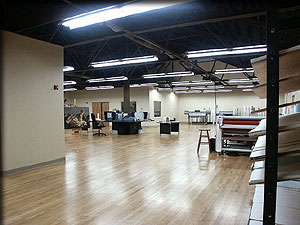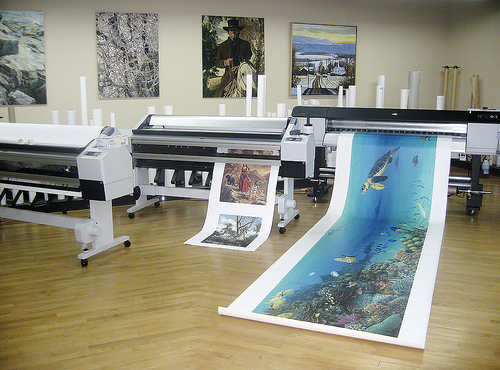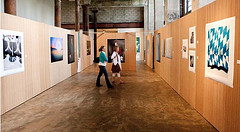By Darren Vena
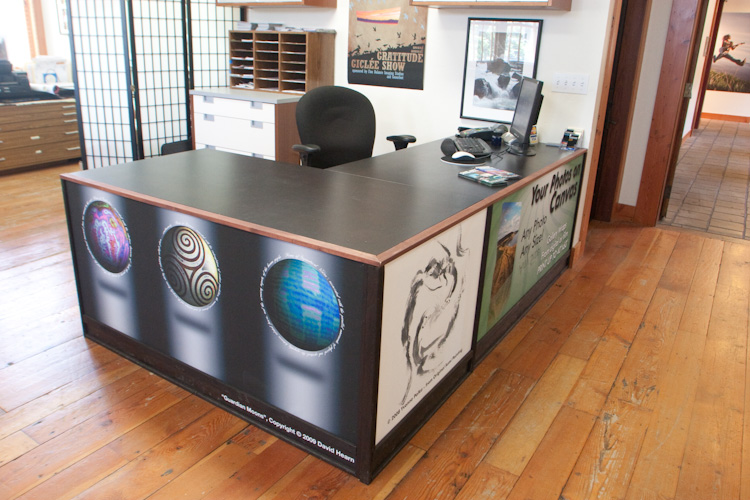
At LexJet, we love it when photographers and artists send us pictures that show some of the creative ways they are using some of the inkjet-printable materials we sell.
In two previous posts on this blog (about photographers Leslie D. Bartlett and David DeJonge), we’ve shown you why LexJet’s Water-Resistant Satin Cloth is quickly becoming a popular option for printing photo and art exhibitions. For one thing, the inkjet-receptive coating on this smooth, lustrous, wrinkle-resistant cloth is designed for high-resolution, full-color imaging. And, because prints on Water Resistant Satin Cloth don’t need to be framed or mounted, shipping exhibition prints from one site to another is a breeze.
But here’s one use of Water-Resistant Satin Cloth that we hadn’t seen until now. The clever, desk-front display system shown here was devised by Joe Menth of Fine Balance Imaging on Whidbey Island, Washington, a mecca for artists, photographers, and nature-lovers about 25 miles north of Seattle.
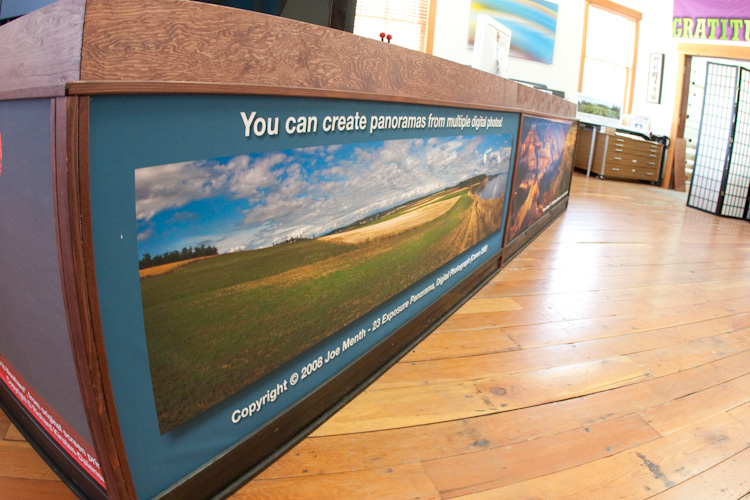 Joe built the desktop display system earlier this year when Fine Balance Imaging moved into a spacious new studio, which was more than twice the size of their original working quarters. He says the desks from the old location simply looked out of place in their new surroundings.
Joe built the desktop display system earlier this year when Fine Balance Imaging moved into a spacious new studio, which was more than twice the size of their original working quarters. He says the desks from the old location simply looked out of place in their new surroundings.
So he customized the desks with fixtures designed to hold changeable graphic panels made from satin-cloth prints attached to recycled door moldings. (The door moldings are used like stretcher bars in canvas gallery wraps.) The panels can be slid in and out of slats in the desk fixtures whenever Fine Balance Imaging wants to feature something new.
“In the desks, the panels looks seamless and permanent because we’ve put trim over the top,” says Menth. “But we simply pull up the trim, pull out the frame, and drop the new prints in.”
The images are printed onto LexJet Water Resistant Satin Cloth using the ImagePrint RIP and the Epson Stylus Pro 9800 printer.
The desktop graphic panels are just one of the ways that Menth shows clients what’s possible with high-resolution inkjet printing and different types of materials. As you can see from Joe’s panoramic shot below, when clients walk into Fine Balance Imaging they see bold splashes of color almost anywhere they look.
Along with promotions for the studio’s services, visitors can see small exhibitions of the work produced by clients such as Michael Foley. His macrophotography series Miracles in Minutiae was printed on LexJet’s Sunset Select Matte Canvas and is displayed for everyone to see. In the corner of the studio is a print on an aluminum sheet made possible with Golden Digital Grounds for Non-Porous Surfaces. Hanging above the desk are paintings enlarged to 400% and printed onto Color Textiles Habotai Silk. Most of the framed photographs were printed on Epson UltraSmooth Fine Art paper.
As for promotional graphics, a front counter sign is printed on LexJet Water-Resistant Polypropylene and the graphics in the I-Banner Stands are printed on either Water-Resistant Polypropylene or Water-Resistant Satin Cloth.
Fine Balance Imaging was founded in 2004, a couple of years after Nancy McFarland and her son Joe Menth had moved to Whidbey Island intending to start a small, family-run art gallery. Nancy and Joe are both photographers and artists at heart, but had worked mostly in technology-related careers that they never were fully passionate about.
At the art gallery, they started making small art prints for a few of their new artist friends. They opened Fine Balance Imaging in direct response to what the artists in the area said they needed. The fine-art business has since expanded to include an extensive array of capture, design, finishing, and marketing-support services for artists, photographers, small businesses, and consumers. These services include: high-end film and flatbed scanning; photography; graphic design; panorama stitching of multiple images; and photo restoration, color correction, and retouching.
But the bulk of the studio’s business revolves around wide-format printing of fine art, photographs, posters, banners, and displays. The studio uses the Epson Stylus Pro 4800, 7600, and 9800 printers with ColorByte Software’s ImagePrint RIP for consistent color from print to print.
For artists who want prints ready to sell at local festivals, Fine Balance will provide shrink-wrapped or polybagged mounted prints. Finishing options include UV-coating, hand deckling, or custom trimming.
As their services have expanded, so has their base of customers. And that’s why they needed to move to a bigger space and chose to do something more creative with their desks. When more customers see for themselves the type of images that can be produced on Water-Resistant Cloth, Menth says, “More and more clients are using it to create frame-free, ready-to-hang art.” Fine Balance Imaging sells the prints complete with a simple hanging system made from dowels and satin cord.
This type of ingenuity in producing ready-to-hang prints that has made Fine Balance Imaging very popular with their clients. Plus, “Doing work that we truly love motivates us to uphold incredibly high standards,” says Joe.
He adds that, “Our clients don’t care what equipment is used to create their prints. They just care that we spend time with them personally to make sure that they’re happy when they leave, so they will come back to us again and again.”
You can read more about Fine Balance Imaging and how they find ways to help artists succeed in LexJet’s In Focus Newsletter (Vol. 4, No. 7) and in future posts on Studio LexJet. Or visit the Fine Balance Imaging website: www.fbistudios.com


